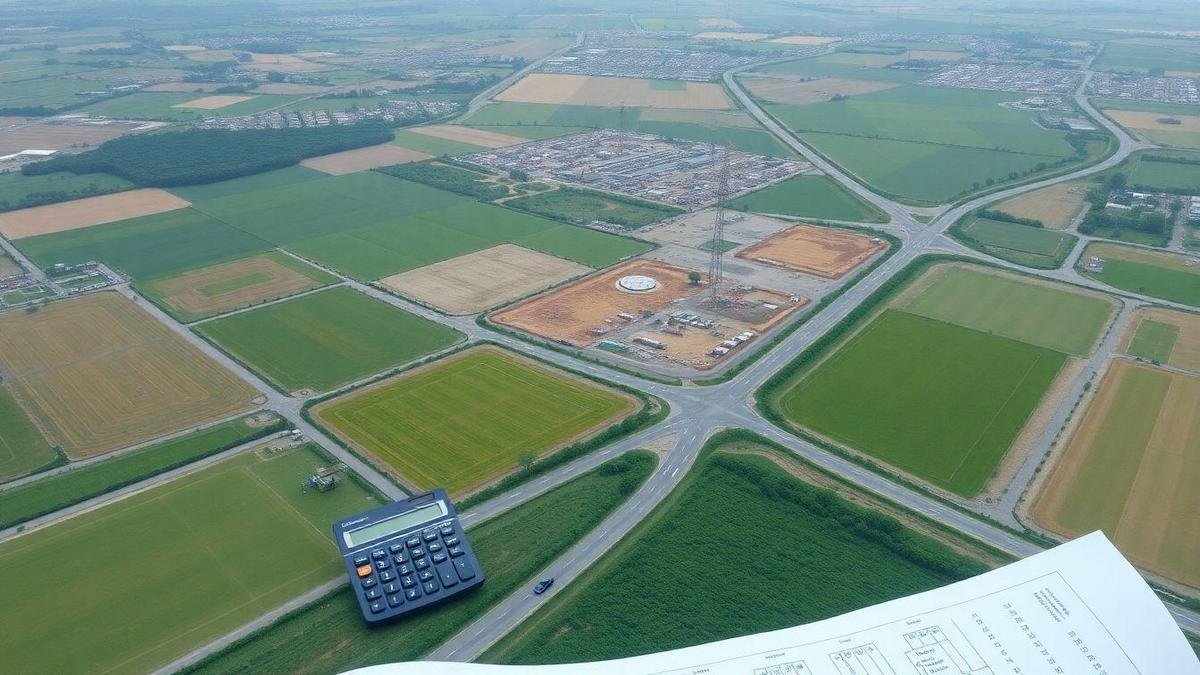The land development checklist is an essential tool for anyone involved in real estate investment. It outlines key elements that guide investors through the complex process of property development. This article will explore the importance of having a comprehensive checklist, the benefits it brings, and effective strategies for land acquisition. Readers will also learn about assessing risks, navigating zoning laws, and implementing sustainable practices. With these insights, investors can make informed decisions and boost their chances of success in land development.
- Understanding local laws is crucial.
- Assess land value before buying. For effective strategies on this, refer to how to value undeveloped land.
- Check for utilities and services availability.
- Look into future area developments. Explore land development trends to anticipate future changes.
- Hiring experts can save time and money.

Understanding the Land Development Checklist
Key Elements of a Land Development Checklist
A land development checklist is a vital tool for investors and developers. It helps them navigate the various steps involved in transforming raw land into a usable space. Here are the key elements that should be included:
- Site Analysis: Evaluating the land’s physical characteristics, zoning laws, and environmental regulations.
- Financial Planning: Estimating costs, potential returns, and securing financing. For insights on financing options, check out land development financing options.
- Permits and Approvals: Identifying necessary permits and understanding the approval process from local authorities. Learn more about the permitting process.
- Design and Planning: Outlining the layout, infrastructure, and overall design of the project.
- Construction Management: Coordinating construction activities, timelines, and contractor management.
- Marketing Strategy: Developing a plan to promote and sell or lease the property once completed. Explore effective marketing strategies for land.
Importance of a Comprehensive Checklist
A comprehensive checklist is essential for successful land development. It acts as a roadmap, guiding investors through each phase of the project. Without it, one might overlook critical steps, leading to costly delays or legal issues. This checklist helps keep all team members on the same page, ensuring everyone knows their responsibilities and deadlines.
Benefits of Using a Land Development Checklist
Utilizing a land development checklist brings several benefits:
| Benefits | Description |
|---|---|
| Increased Efficiency | Streamlines the development process, saving time. |
| Risk Management | Identifies potential risks early, allowing for mitigation. For a deeper understanding of risk assessment, refer to investment risk assessment. |
| Cost Control | Helps track expenses and stay within budget. Check out the cost breakdown for better budgeting. |
| Improved Communication | Enhances collaboration among stakeholders. |
| Accountability | Assigns clear roles and responsibilities. |
By employing a land development checklist, investors can navigate the complexities of the development process with confidence. It acts as a safeguard, ensuring that no stone is left unturned.

Smart Investors Guide to Property Investment Planning
Steps for Effective Property Investment Planning
When it comes to property investment, having a solid plan is crucial. Here are some essential steps that smart investors should follow:
- Research the Market: Understand local trends and property values. This helps in making informed decisions.
- Set Clear Goals: Define what they want to achieve. Is it rental income, capital growth, or a mix of both?
- Create a Budget: Outline how much they can invest. This includes purchase price, taxes, and maintenance costs.
- Choose the Right Property: Look for properties that meet their investment goals. Location, size, and condition matter.
- Analyze Potential Returns: Calculate expected rental income and appreciation. This will help gauge the investment’s viability.
- Consider Financing Options: Evaluate various financing methods. This could be through loans or partnerships. For more details, check the financing options.
- Develop an Exit Strategy: Plan how to sell or rent the property in the future. This prepares them for any situation.
Common Mistakes in Property Investment
Even seasoned investors can slip up. Here are some common pitfalls to avoid:
- Ignoring Market Research: Not understanding the market can lead to poor choices.
- Overextending Finances: Spending beyond their means can lead to financial strain.
- Neglecting Property Management: Poor management can decrease property value and rental income.
- Failing to Diversify: Investing all funds in one property can be risky. Learn more about common mistakes in land development.
- Skipping Legal Checks: Not reviewing legal documents can lead to future headaches.
How a Smart Investors Guide Can Help
A smart investors guide provides valuable insights and strategies for navigating the property investment landscape. It offers:
- Step-by-step Instructions: Clear guidance on what to do at each stage of the investment process.
- Market Analysis Tools: Resources to assess market conditions and property values.
- Financial Planning Templates: Tools to help create budgets and analyze potential returns.
- Risk Management Strategies: Tips on how to minimize risks associated with property investment.
By utilizing a well-structured land development checklist, investors can streamline their planning process and avoid common mistakes. This checklist acts as a roadmap, guiding them through every aspect of property investment, from initial research to final purchase.

Essential Land Acquisition Strategies
Techniques for Successful Land Acquisition
Successful land acquisition requires a strategic approach. Investors must be proactive, utilizing various techniques to secure valuable properties. Here are some effective methods:
- Research and Networking: Investors should tap into local networks and attend industry events. Building relationships with brokers, developers, and local officials can unveil opportunities.
- Due Diligence: Conducting thorough research on potential land can reveal hidden issues or advantages. This includes checking zoning laws, environmental regulations, and market trends. For a more detailed process, refer to due diligence processes.
- Negotiation Skills: Strong negotiation skills are essential. Investors must be prepared to discuss terms and conditions that meet both their needs and those of the seller.
- Utilizing Technology: Digital tools can provide valuable insights. Geographic Information Systems (GIS) and property databases can help investors visualize land potential.
Evaluating Land Value and Potential
Evaluating land value is crucial for making informed decisions. Investors should consider several factors that can affect the worth and potential of a property:
| Factor | Description |
|---|---|
| Location | The area’s accessibility and amenities. |
| Zoning Regulations | Laws that dictate how the land can be used. For more on this, check land use restrictions. |
| Market Trends | Current demand for land in the region. |
| Environmental Factors | Natural features that impact development. |
| Future Developments | Upcoming projects that could affect land value. |
By analyzing these factors, investors can make smarter choices.

Investment Risk Assessment in Land Development
Identifying Risks in Real Estate Development
In the world of real estate development, various risks can arise, impacting investments significantly. Investors must recognize these potential pitfalls to make informed decisions. Common risks include:
- Market Risk: Fluctuations in demand and pricing can affect property values.
- Financial Risk: This involves interest rates and financing availability that can change unexpectedly.
- Regulatory Risk: Changes in laws or zoning regulations can halt or delay projects. For a guide on navigating these laws, see navigating zoning changes.
- Environmental Risk: Issues like contamination or natural disasters can threaten land viability.
Understanding these risks is crucial for investors. A land development checklist can help in identifying and evaluating these risks systematically.
Tools for Effective Risk Assessment
Investors have access to several tools that can aid in risk assessment. These tools help in evaluating the landscape of land development more clearly:
| Tool | Description |
|---|---|
| SWOT Analysis | Identifies Strengths, Weaknesses, Opportunities, and Threats. |
| Risk Matrix | Visual representation of risks based on likelihood and impact. |
| Financial Models | Forecasts potential returns and costs associated with a project. |
| Site Analysis Reports | Evaluates the physical and environmental aspects of a location. |
Utilizing these tools can make the process of identifying risks more manageable. Each tool provides a different perspective, allowing investors to see the bigger picture.
Mitigating Risks in Land Development Projects
To navigate the complexities of land development, investors should employ strategies to mitigate risks. Here are some effective approaches:
- Thorough Due Diligence: Conduct comprehensive research on the land, market conditions, and potential challenges.
- Diversification: Spread investments across various projects or regions to reduce exposure to any single risk.
- Insurance: Obtain appropriate insurance coverage to protect against unforeseen events.
- Engaging Experts: Collaborate with professionals such as architects, legal advisors, and environmental consultants to gain insights and guidance.
By implementing these strategies, investors can safeguard their projects and enhance their chances of success.
Navigating Zoning and Permits
Understanding Zoning Laws and Their Impact
Zoning laws are rules that dictate how land can be used. They help shape communities by determining what can be built and where. For investors, understanding these laws is crucial. They can affect the value of property and the types of projects that can be developed. To learn more about the basics, see zoning for beginners.
For example, if an investor buys land in a zone meant for residential use, they may not be able to build a commercial building. This limitation can lead to lost opportunities. Therefore, it is essential for investors to research local zoning laws before making any decisions.
Steps to Obtain Necessary Permits
Obtaining permits can feel like a maze, but breaking it down into steps can simplify the process. Here’s a basic roadmap:
- Research Local Laws: Understand the zoning laws in the area.
- Prepare Documentation: Gather all necessary documents, including property deeds and development plans.
- Submit Applications: Fill out and submit the required applications to the local government. For more on this process, refer to site plan approvals.
- Attend Meetings: Be ready to present the project at public meetings or hearings.
- Receive Approval: If all goes well, receive the necessary permits to proceed.
Each of these steps is vital. Missing one could delay or even halt a project.
The Role of Zoning in Land Development Checklist
To keep track of the important aspects of zoning and permits, a land development checklist can be invaluable. Here’s a simple table to illustrate key items to consider:
| Checklist Item | Description |
|---|---|
| Zoning Classification | Identify the zoning type for the property. |
| Permitting Requirements | List all permits needed for the project. |
| Community Impact Assessments | Consider how the project will affect the community. |
| Public Hearing Dates | Note any upcoming meetings for project approval. |
This checklist serves as a guide to ensure that no critical steps are overlooked.
Site Analysis Techniques for Investors
Importance of Site Analysis in Development
Site analysis plays a crucial role in the land development process. Investors must understand the land’s potential before making any decisions. A thorough site analysis can reveal both opportunities and challenges. It allows investors to make informed choices, minimizing risks and maximizing returns.
For instance, consider an investor eyeing a plot of land in a growing city. By conducting a detailed site analysis, they can identify nearby amenities, zoning laws, and environmental factors. This knowledge can be the difference between a profitable investment and a costly mistake.
Key Factors to Consider During Site Analysis
When conducting site analysis, several key factors should not be overlooked. These include:
- Location: Proximity to schools, hospitals, and transportation can affect property value.
- Zoning Regulations: Understanding local laws can dictate what can be built on the land.
- Environmental Conditions: Soil quality, drainage, and natural hazards must be assessed.
- Market Trends: Knowing current and future demand in the area helps gauge investment potential.
| Factor | Importance |
|---|---|
| Location | Affects accessibility and desirability |
| Zoning Regulations | Determines allowable uses and development types |
| Environmental Conditions | Impacts construction and long-term viability |
| Market Trends | Guides investment strategy and timing |
Tools for Effective Site Analysis
Investors have a variety of tools at their disposal for effective site analysis. These tools help streamline the process and provide valuable insights. Some popular options include:
- GIS Software: Geographic Information Systems (GIS) help visualize data related to land use, demographics, and environmental factors.
- Surveying Equipment: Tools like total stations and GPS devices assist in accurately measuring land features.
- Market Analysis Reports: These reports offer insights into property values and trends in the area.
Using these tools, investors can make better-informed decisions and enhance their chances of successful land development.
Sustainable Land Development Practices
Benefits of Sustainable Development
Sustainable development in land management brings numerous advantages. First, it conserves natural resources. By using materials wisely, developers can protect the environment. This leads to healthier ecosystems. It also creates economic opportunities. Sustainable projects often attract investors looking for long-term gains. Lastly, it enhances the community’s quality of life. Green spaces and clean energy options make neighborhoods more appealing.
Strategies for Implementing Sustainability
To put sustainability into practice, developers can follow several strategies:
- Use Renewable Resources: Opt for solar panels and wind energy.
- Promote Efficient Water Use: Install rainwater harvesting systems.
- Design for Energy Efficiency: Build homes that require less energy for heating and cooling.
- Encourage Sustainable Transport: Create bike paths and access to public transport.
These strategies help in creating projects that not only support the environment but also appeal to modern investors.
How Sustainability Fits into the Land Development Checklist
When working on a land development checklist, sustainability should be a key point. Here’s how it can be integrated:
| Checklist Item | Sustainability Aspect |
|---|---|
| Site Selection | Choose areas with minimal environmental impact |
| Design and Planning | Incorporate green building practices |
| Material Use | Source locally and sustainably |
| Community Engagement | Involve locals in the planning process |
| Long-term Impact Assessment | Evaluate environmental and social effects |
Each item on this checklist plays a critical role in ensuring that development is not just efficient but also responsible.

Capital Planning for Investors
Importance of Capital Planning in Development
Capital planning plays a critical role in land development projects. For investors, it acts as a roadmap that guides financial decisions and resource allocation. By carefully planning capital, investors can identify potential risks and opportunities, which helps them make informed choices. This proactive approach not only safeguards investments but also maximizes returns over time.
Budgeting for Land Development Projects
Budgeting is the backbone of any successful land development initiative. A well-structured budget outlines expected costs and revenues, providing a clear picture of financial health. It includes various elements such as:
- Land Acquisition Costs: The price of purchasing the land.
- Construction Expenses: Costs related to building structures and infrastructure.
- Permitting Fees: Expenses for obtaining necessary approvals and licenses. For a detailed overview, see permitting fees.
- Marketing Costs: Funds allocated for promoting the project.
Accurate budgeting allows investors to track spending and adjust as needed. It also helps in comparing actual expenses against projected figures, ensuring that the project remains on track.
Effective Capital Planning Strategies
To achieve successful capital planning, investors can adopt several strategies:
| Strategy | Description |
|---|---|
| Conduct Thorough Research | Understand market trends and local regulations. |
| Set Clear Objectives | Define what the project aims to achieve financially. |
| Create Contingency Plans | Prepare for unexpected costs or delays. |
| Engage Financial Experts | Consult with financial advisors for tailored insights. |
By using these strategies, investors can navigate the complexities of land development with greater confidence and clarity.

Real Estate Development Tips for Success
Best Practices in Real Estate Development
In the competitive landscape of real estate, success hinges on a few key practices. Investors must focus on thorough research before diving into any project. Understanding local markets, zoning laws, and community needs can make a significant difference.
Collaboration is another cornerstone. Working with architects, planners, and local officials can help streamline the process and avoid costly mistakes. Regular communication with stakeholders helps keep everyone on the same page.
Investors should also prioritize sustainability. Eco-friendly practices not only appeal to modern buyers but can also lead to long-term cost savings. Incorporating green spaces and energy-efficient designs can enhance property value.
Learning from Successful Development Projects
Looking at successful projects can provide valuable insights. For instance, a mixed-use development in a bustling urban area can show how blending residential and commercial spaces can create vibrant communities.
Another example is a revitalization project that transformed a neglected neighborhood into a thriving hub. This project highlighted the importance of community involvement and feedback. Engaging with residents can lead to a development that truly meets their needs.
Incorporating Tips into the Land Development Checklist
To make the most of these insights, investors can create a land development checklist. Here’s a simple table to illustrate key points for this checklist:
| Checklist Item | Description |
|---|---|
| Market Research | Analyze local demand and trends |
| Community Engagement | Involve locals in the planning process |
| Sustainability Practices | Implement eco-friendly building methods |
| Collaboration with Experts | Partner with architects and planners |
| Financial Planning | Create a detailed budget and funding strategy |
By incorporating these elements into their land development checklist, investors can navigate the complexities of real estate development with confidence and clarity.
In the End…
The land development checklist serves as an indispensable guide for investors navigating the intricate world of real estate development. By emphasizing key elements such as site analysis, financial planning, and risk assessment, it empowers investors to make informed decisions and avoid common pitfalls. The benefits of utilizing a comprehensive checklist are manifold, from increased efficiency to improved communication among stakeholders. Furthermore, understanding zoning laws, conducting thorough site analyses, and implementing sustainable practices are crucial strategies that enhance the overall success of land development projects.
By adopting these best practices and integrating them into their planning processes, investors can not only maximize their returns but also contribute positively to their communities. As they embark on their journey in land development, they are encouraged to explore more insightful articles at Land Development Hub to further enrich their knowledge and strategies.
Eduardo Bugallo, PhD.

One response
[…] Land Development Checklist: 10 Must-Know Steps Smart Investors Forget on How to Value Undeveloped Land for InvestorsAugust 26, 2025 […]